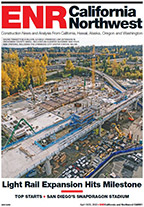Sunrise Powerlink transports renewable energy overhead and underground for 117 miles from the Imperial Valley near El Centro into San Diego—increasing regional transmission capability and reliability. It also helps San Diego Gas & Electric (SDG&E) meet a state mandate requiring at least 33% of its energy to come from renewable resources by 2020.

The $1.88-billion project began Sept. 1, 2010, and was energized on June 17, 2012—just in time to provide additional summer reliability to the Southern California power grid. SDG&E estimates that the project created between 400 and 500 direct construction jobs, providing a boost for the area's construction industry, which was hit by the recession.
Sunrise Powerlink includes overhead transmission, underground transmission and a 500-kV/230-kV substation. The 89-mile-long, single-circuit overhead 500-kV circuit stretches from El Centro to rural Alpine. At that point, the Suncrest substation transforms the 500 kV to 230 kV. Two 230-kV circuits continue west for 22 miles, incorporating a six-mile, double-circuit 230-kV underground portion beneath a main county road and through Alpine's business district.
Mike Niggli, SDG&E president and chief operating officer, says, "Building a major infrastructure project like the Sunrise Powerlink was not a simple, by-the-book task, and given the fact that it's been more than 25 years since SDG&E constructed a 500-kV transmission line, many more elements today were involved in the overhead and underground design, engineering, procurement of supplies and habitat schedules."
The 11,000-page environmental impact report and statement was the largest in California history for a transmission line, according to SDG&E. Seventy-five public hearings were held and more than 320 mitigation measures were prescribed, including protecting peninsular bighorn sheep and golden eagles.
Of the 438 structure sites, 234 are in rugged terrain. Towers were placed to minimize their impact on the skyline. Even the steel color was modified in select locations to make them less conspicuous.
The substation, completed in 16 months, was constructed in remote mountainous terrain east of Alpine. It required more than 120 dynamite blasts to break down the granite, which exceeded 1.2 million cu yd. In addition, access to the project site required a new 30-ft-wide, two-mile-long paved road.
Because the project involved such elements as micropile foundations and bolted steel micropile caps, the team made substantial use of helicopters. As many as 30 helicopters were used each day and recorded more than 30,000 flight hours.
Niggli adds, "Constructing the transmission line through rough mountainous desert terrain, with a large portion of the towers and foundations needing to be erected using helicopters, required our dedicated team to be innovative and cutting-edge in all design and engineering aspects and to bring the project on line—on time, on budget and safely."
SDG&E and its Sunrise contractors tallied more than 5.5-million worker-hours. The company notes that its lost-time rate of 1.79 was less than half the industry average for similar utility projects.
Sunrise Powerlink
San Diego and Imperial Counties
Key Players
Owner: San Diego Gas & Electric, Alpine
Contractor: PAR Electrical Contractors, Escondido
Lead Design: Burns and McDonnell, Kansas City, Mo.
Suncrest Substation: Beta Engineering, Pineville, La.
Suncrest Substation/Grading: Nolte, San Diego
Underground Transmission: Black and Veatch, Overland Park, Kan.
Submitted by San Diego Gas & Electric



Post a comment to this article
Report Abusive Comment